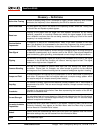
Ridge Tool Company Elyria, Ohio U.S.A www.seektech.com 39
SeekTech SR-60
Orientation to the Signal
Because of the multiple signals being processed by
each Omnidirectional antenna, the target’s signal
always gets stronger as the receiver gets closer to
the target. How the unit is held does not affect Signal
Strength. The user can approach from any direction
and does not need to know the orientation or
direction of the pipe or wire.
Locating Sondes
Used with a Sonde, the SR-60 eliminates Nulls and
"Ghost Peaks”. A conventional locator signal often
sees a signal increase followed by a null (better
described as no signal registering on the antenna)
and then a peak. This can confuse the operator who
may interpret a smaller peak as the target.
Figure 70: The signal from a Sonde as “seen” by a
conventional locator
The main peak is in the center, and two false
peaks are outside the two nulls.
The SR-60 uses measurements of the complete field
to direct the user to the target. Finding a Sonde using
Signal Strength is a very direct process.
Figure 71: Sonde signal as “seen” by the SR-60
The only way to go is “up” toward the maximum
signal.
More on Informational Locating
Because of the SR-60’s advanced processing and
display, the information provided by the SR-60 makes it
clear when a locate is reliable, and when one is suspect.
A good locator can understand the underground picture
with much less effort by using the combined information
provided by:
• Proximity Signal/Signal Strength
• Tracing Line
• Distortion Indicator
• Guidance Arrows and Directional Sound
• Continuous Measured Depth indications
These indicators show what the antennas are “sensing”
as they move through the field. They signal when a field
is being distorted out of shape by interference from
other cables, pipes, or conductive objects nearby. When
significant distortion is present, the indicators will not
agree. Knowing distortion is present allows the operator
the option of taking action to reduce it or at least
account for it. (For example, both location and
Measured Depth reading become suspect in distorted
fields).
The other side of having more information is verification
that a locate is reliable. If all of the indicators are in
agreement and reasonable then the degree of
confidence in a locate can be much higher.
SR-60 Maintenance
Transportation and Storage
Before transporting, make sure that the unit is off to
preserve battery power.
When transporting, make sure that the unit is secure and
does not bounce around or get bumped by loose
equipment. The SR-60 should be stored in a cool dry
place.
Note: If storing the SR-60 for an extended
period, remove the batteries completely.
If shipping the SR-60, remove the batteries
entirely from the unit.
Installing/Using Accessories
The SR-60 also comes with Sonde and Pole Markers
that can be used to mark Pole or Sonde locations above
ground. There are two (2) red markers to mark the Poles
and one (1) yellow marker to mark the Sonde. The
markers can also be used to temporarily mark points to
come back to while scouting a target area or tracing a


















